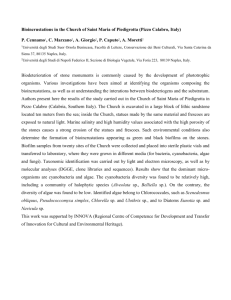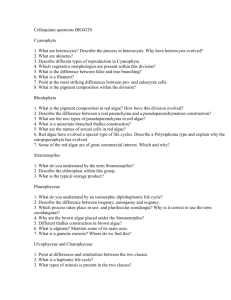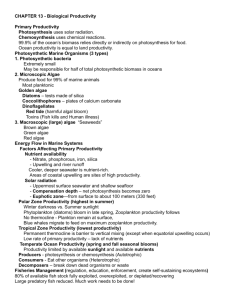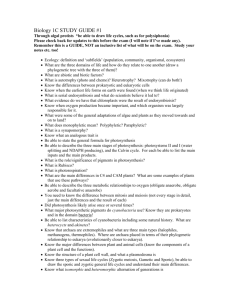Evolution of Plant Communities
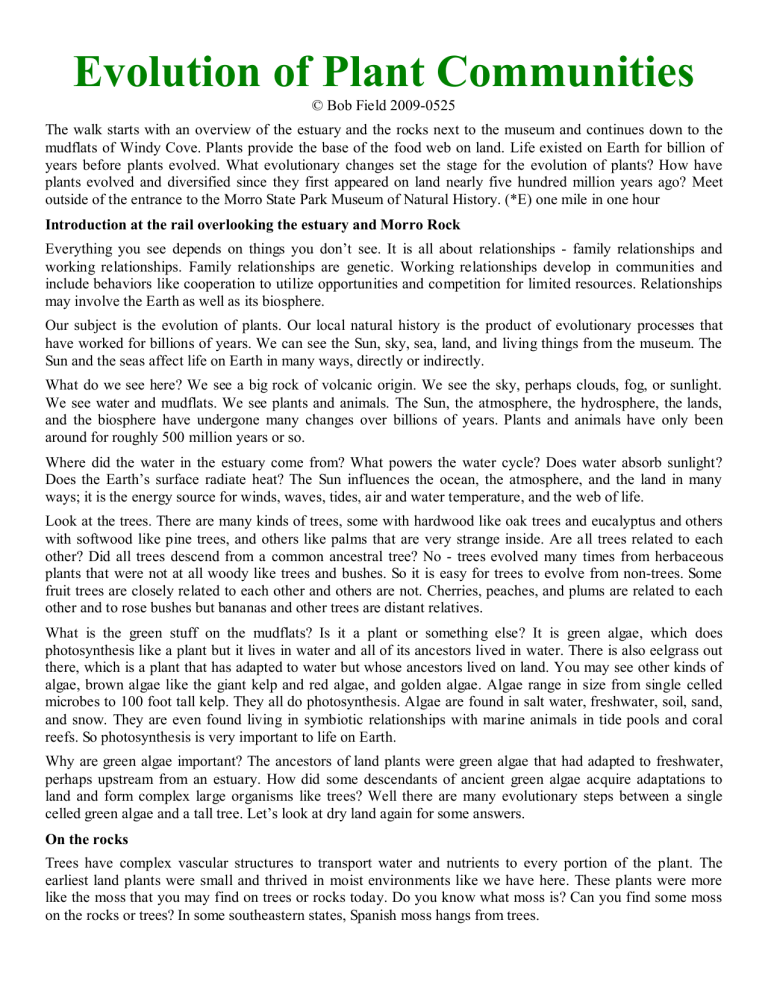
Evolution of Plant Communities
© Bob Field 2009-0525
The walk starts with an overview of the estuary and the rocks next to the museum and continues down to the mudflats of Windy Cove. Plants provide the base of the food web on land. Life existed on Earth for billion of years before plants evolved. What evolutionary changes set the stage for the evolution of plants? How have plants evolved and diversified since they first appeared on land nearly five hundred million years ago? Meet outside of the entrance to the Morro State Park Museum of Natural History. (*E) one mile in one hour
Introduction at the rail overlooking the estuary and Morro Rock
Everything you see depends on things you don’t see. It is all about relationships - family relationships and working relationships. Family relationships are genetic. Working relationships develop in communities and include behaviors like cooperation to utilize opportunities and competition for limited resources. Relationships may involve the Earth as well as its biosphere.
Our subject is the evolution of plants. Our local natural history is the product of evolutionary processes that have worked for billions of years. We can see the Sun, sky, sea, land, and living things from the museum. The
Sun and the seas affect life on Earth in many ways, directly or indirectly.
What do we see here? We see a big rock of volcanic origin. We see the sky, perhaps clouds, fog, or sunlight.
We see water and mudflats. We see plants and animals. The Sun, the atmosphere, the hydrosphere, the lands, and the biosphere have undergone many changes over billions of years. Plants and animals have only been around for roughly 500 million years or so.
Where did the water in the estuary come from? What powers the water cycle? Does water absorb sunlight?
Does the Earth’s surface radiate heat? The Sun influences the ocean, the atmosphere, and the land in many ways; it is the energy source for winds, waves, tides, air and water temperature, and the web of life.
Look at the trees. There are many kinds of trees, some with hardwood like oak trees and eucalyptus and others with softwood like pine trees, and others like palms that are very strange inside. Are all trees related to each other? Did all trees descend from a common ancestral tree? No - trees evolved many times from herbaceous plants that were not at all woody like trees and bushes. So it is easy for trees to evolve from non-trees. Some fruit trees are closely related to each other and others are not. Cherries, peaches, and plums are related to each other and to rose bushes but bananas and other trees are distant relatives.
What is the green stuff on the mudflats? Is it a plant or something else? It is green algae, which does photosynthesis like a plant but it lives in water and all of its ancestors lived in water. There is also eelgrass out there, which is a plant that has adapted to water but whose ancestors lived on land. You may see other kinds of algae, brown algae like the giant kelp and red algae, and golden algae. Algae range in size from single celled microbes to 100 foot tall kelp. They all do photosynthesis. Algae are found in salt water, freshwater, soil, sand, and snow. They are even found living in symbiotic relationships with marine animals in tide pools and coral reefs. So photosynthesis is very important to life on Earth.
Why are green algae important? The ancestors of land plants were green algae that had adapted to freshwater, perhaps upstream from an estuary. How did some descendants of ancient green algae acquire adaptations to land and form complex large organisms like trees? Well there are many evolutionary steps between a single celled green algae and a tall tree. Let’s look at dry land again for some answers.
On the rocks
Trees have complex vascular structures to transport water and nutrients to every portion of the plant. The earliest land plants were small and thrived in moist environments like we have here. These plants were more like the moss that you may find on trees or rocks today. Do you know what moss is? Can you find some moss on the rocks or trees? In some southeastern states, Spanish moss hangs from trees.
The tiny plants growing on the rocks and trees here are not moss or true land plants at all. They are lichens? Do you know what kingdom lichens are in? What are the five or six kingdoms of life: plants, animals, algae, fungus, and bacteria? Lichen is a combination of individuals from two or three kingdoms. All lichens are symbioses between a fungus and something that does photosynthesis. A symbiosis is a partnership between unrelated species. Do you know what a fungus is? It could be a mushroom or it could have other forms. Fungi digest their food before they ingest it, unlike animals that have to ingest and then digest their food. Successful fungi live motionlessly along side their food supply unlike animals that are animated to follow food sources.
A fungus can resist dehydration although it prefers moist environments. The fungus cannot make its own food and it cannot do photosynthesis. It gets its food and energy from others, from living or decomposing organisms.
Fungus also can get essential nutrient phosphates by dissolving rocks with acids that it produces and secretes.
So they have to have relationships with other things in order to survive.
Who provides the organic carbon and energy for the fungus? In the lichen, the fungus has an intimate durable relationship with either algae or cyanobacteria or both. It protects its partner and gains food. The partner utilizes sunlight, water, carbon dioxide, and some nutrients from the fungus. If the partner does not do its job, the fungus dissolves the partnership – and the partner!
There are many kinds of lichen on the rocks here. Look closely at the gray and black spots – that is not bird guano – although there is some here naturally. You are looking at crustose lichen which forms a thin flat crust on rocks. Foliose lichen rises slightly above the surface like the foliage on a tree. The large lichen hanging from trees like fruit are fruticose.
So lichen lived on land before the first plants. The first plants were simple moss-like organisms that lacked vessels to transport water and nutrients. They were therefore limited in size even in damp environments, but could spread across rocks. Neither lichen nor moss could grow on trees because there were no trees! Where did they get their nutrient nitrogen? Some seawater is rich with nutrients but on land everything is more difficult.
Every organism needs nitrogen. Nutrient nitrogen was widely available in water where life first evolved.
Lightning can fix some nitrogen gas into nutrient form. Very few organisms can utilize the abundant nitrogen gas in the atmosphere and oceans. Neither land plants nor algae can fix nitrogen molecules. Some cyanobacteria cells can fix nitrogen from the atmosphere. That is why cyanobacteria are so important. Animal waste is rich in nutrient nitrogen, but awaited the evolution of animals.
Plants inherited the ability to do photosynthesis from their green algae ancestors. Did the algae invent photosynthesis or did they inherit it from their ancestors? The ancestors of green algae were single celled organisms that engulfed their food like amoebas do. They digest and recycled materials for their own growth while extracting energy from the molecules by aerobic respiration, oxidizing sugars and other organic molecules. They ingest and digest cells of cyanobacteria which are much smaller than them and easily engulfed.
Some cyanobacteria live in filaments and colonies that are harder to engulf.
More than a billion years ago, one of these cells engulfed a cyanobacteria but failed to digest it. Perhaps it was not as good at digesting or perhaps the cyanobacteria was unusually resistant or maybe they had grown up together and were friends. It turned out that they formed a symbiotic relationship. The cyanobacteria continued to do photosynthesis and was protected from grazing because it was engulfed in a large cell. It shared the food it made which kept its protector happy and alive.
Over many generations this endosymbiotic relationship prospered and evolved. Endosymbiosis is a form of symbiosis where one organisms lives inside another, in this case inside the actual cell of the larger partner. The cyanobacteria divided and filled its partner with multiple cyanobacteria, each sharing the food they made by photosynthesis. When the partner divided, its offspring inherited photosynthetic partners.
Over time, subsequent generations became more fully interdependent with just the right number of cyanobacteria, not too many, not too few. The cyanobacteria had an easy life and got lazy, giving up many of its independent functions to its partners, even transferring most of its genes. The partner also thrived with this easier lifestyle and gained new powers. Eventually the cyanobacteria atrophied to the point where it was nothing more than an organelle of the partner, a chloroplast whose primary function was and is photosynthesis.
This particular line of cyanobacteria could not fix nitrogen, so neither can its chloroplast descendents in algae and in plants. Why can some cyanobacteria fix nitrogen? This trick requires an enzyme that cannot tolerate oxygen. Billions of years ago, there were no free oxygen molecules in the oceans and the atmosphere.
Cyanobacteria lived and live in communities where most cells do photosynthesis and tolerate the oxygen waste product and a few cells fix nitrogen in an anaerobic environment. They share resources and everyone is happy and thrives.
Chloroplasts evolved independently several times. The common ancestor of the different types of algae is not algae. Green, red, brown, and golden algae acquired chloroplasts from independent instances of endosymbiosis involving cyanobacteria. In the case of the brown algae, the photosynthetic partner was a small algae that had already acquired chloroplasts.
The rock face is pretty barren, but several plants have adapted to this harsh environment. Dudlyea clings to the rock face. It is succulent plant that stores water in its leaves and can survive long dry seasons and periodic droughts, collecting moisture from fog. Among the variations in offspring, the environment makes selections.
As we walk to the mudflats, watch your step, the trail steep and slippery with debris. If you want to look around for a second, stop first.
At Windy Cove
Can you find any types of fungus in this area other than the ones in the lichen? There are fungi associated with the roots of most plants, but you cannot see them because they are underground. They also have symbiotic relationships with plants and help them acquire soluble phosphates. Unlike fungus, plants cannot secrete acids to decompose rocks that contain phosphates. The extensive network of fibers of a fungus increases the plant’s access to nutrients in the soil. Half of the food that the plant transports from its leaves to its roots is shared with its fungal partners.
There is also an extensive collection of bacteria in the soil, some of which fix nitrogen molecules into nutrient forms. Some of these bacteria have symbiotic relationships with plant roots and are enclosed in nodules.
Legumes are a typical example of plants with symbiotic relationships for nitrogen fixation.
Plants convert atmospheric carbon dioxide into carbon rich plant fibers. Animals, fungus, and bacteria consume and/or decompose plant fibers. They release the carbon dioxide to the atmosphere and return the nutrient nitrogen and phosphorus to the soil through their waste products. Eventually plant materials are cycled through the food web and end up decomposed into basic molecules in the atmosphere and the soil. Remarkably, animals cannot extract energy and materials from food efficiently without the digestive assistance of microbes in their guts.
Even the nearly indestructible fibers of cellulose and lignin in trees and woody plants are eventually decomposed by fungus and the carbon is recycled into the atmosphere. Off shore beyond the sandspit, there are peat beds, precursors to coal. Most coal deposits formed from woody plants that evolved strong carbon-based fibers before any decomposers evolved the ability to decompose the fibers. Fossil fuels stored carbon for several hundred million years before human activity began to recycle carbon to the atmosphere at an alarming and unsustainable rate.
Let’s talk about roots, stems, and leaves – it is unlikely that all of the parts of a vascular plant evolved simultaneously. Which came first? You would guess stems because they can transport water and nutrients throughout the plant. Roots are extremely beneficial because they make it easier for plants to access water and nutrients in the soil. Leaves have large surface areas that enhance a plant’s ability to collect sunlight. Leaves may have evolved originally as spines to ward off grazing animals.
Do you think that the algal ancestors of plants were freshwater algae or saltwater algae? Did they emerge on a beach, or a mudflat of an estuary, or on a less salty back bay where more freshwater mixes with the tide driven salt water or upstream in freshwater creeks or lake?
The earliest plants produced spores. Spores are small and lightweight and easily dispersed by the winds. Spores that settle in moist soil develop a sperm and egg that merge to produce a new plant. Some plants evolved the
ability to produce pollen to fertilize eggs and form seeds. Still later plants produce flowers and fruits. Plants with the most successful adaptations have become most prevalent and most highly diversified, but plants continue to thrive in suitable environments with even the least recently evolved traits.
Plants and animals co-evolve by means of natural selection of the diverse traits present in any population of organisms. The selection may be driven by changing environments or by migration to new environments. Plants reward and repel animals like insects, birds, reptiles, and mammals seeking food and shelter. All of the parts of a colorful and fragrant flower evolved from stems with modified leaves of precisely controlled size and shape.
Flowers attract insects that transfer pollen in exchange for the high energy nectar the flower also produces.
Small birds like hummingbirds also got into the act and contribute to pollination.
Colorful and fragrant fruits attract birds, reptiles, and mammals and reward them with food. The seeds are resistant to digestion in the animal gut, but often are activated by digestive juices that make it easier for them to germinate after they have been dispersed by an animal along with the nutrients in the animal waste. Some spicy fruits discourage some animals and attract others.
Plants are solar powered chemical factories making proteins, sugars, fats, toxins, pigments, and fragrances. In addition to flowers and fruits, plants often produce substances that attract or repel animals including fragrances, flavors, and toxins. Many other organisms including single celled microbes produce toxins as well. The ability to absorb, reflect, or scatter light and color also influences the survivability of organisms encompassing photosynthesis (light collection for energy), sensing light sources and images (light collection for information), and alterations in an organism’s visibility (camouflage, warning colors, attractive displays). We can speculate on the evolutionary history of poison oak, hemlock, milkweed, and Monarch butterflies.
In summary
Organisms rely on solar and/or geothermal energy sources and fluids and nutrients from the air, water, and land.
The appearance and behavior of plants and animals are adaptations to daily and seasonal changes in the environment including tides and weather that evolved over millions of years by means of natural selection.
Siblings have different traits because they inherit different combinations of their parent’s genes. Chance mutations of DNA introduce additional variations. The diversity of traits acquired genetically by offspring affects their fitness in various environments. When the environment changes or when organisms migrate into new environments, natural selection determines which traits persist in populations.
Chance mutations of DNA enabled some descendants of green algae to evolve into multicellular, differentiated, vascular plants with the ability to form leaves and to form and disperse seeds through the production of flowers and fruits. Flowering plants evolved from algae with help from bacteria (fixing nitrogen), fungi (phosphorus and minerals from the soil), and animals (insect, bird, or bat pollinators). Many plants also rely on animals to spread seeds which are often contained in fruits that attract animals.
Co-evolution, cooperation, competition, and reproductive strategies are all factors in the ecosystem that includes all five living kingdoms. Over generations, populations evolve by means of natural selection of certain traits as they radiate into new environments or as conditions change.
In the museum
We can visit the museum for a brief guided tour of the exhibits and for a more thorough discussion of the origin, evolution, diversity, abundance, and distribution of plants. We can discuss relationships of plants with each other and with the other kingdoms of life: animals, algae, fungi, and bacteria and we can discuss the coevolution of the Earth and its biosphere.
On the web
We have placed additional material online for review. You can also use Google and Wikipedia to locate additional information related to the evolution of plants and the structure and evolution of the Earth and its biosphere. As a starting point, go to www.calpoly.edu/~rfield/Darwin.htm
. One of the links from this page will
provide you with the text from the “Darwin in the Garden” poster exhibit. The exhibit has the following discussion of the relationships of plants and animals:
Plants are solar powered chemical factories making proteins, sugars, fats, toxins, pigments, and fragrances.
Animals and fungi rearrange the building blocks of life that they consume into more complex molecules. Cells need proteins, polysaccharides, and membranes that are built from amino acids, sugars, and fats. Primary producers like plants not only arrange building blocks, but also create them from simpler molecules like carbon dioxide, water, basic nutrients (nitrates and phosphates), and minerals (iron, silica, calcium, and magnesium).
Sugars and fats contain carbon, hydrogen, and oxygen. All amino acids also contain nitrogen. All nucleic acids also contain nitrogen and phosphates. Magnesium is a critical element in chlorophyll.
Animals use proteins as a source of energy and as building blocks for muscles, but proteins have served critical cellular functions for billions of years. Proteins serve as enzymes or catalysts to promote metabolic processes in all organisms. Enzymes help plants synthesize glucose from carbon dioxide in “the most commonly used chemical reaction by which inorganic carbon enters the biosphere”, as Wikipedia says. Proteins are polymers of amino acids arranged in sequences translated from RNA which is transcribed from DNA.
Plants manufacture pigments for practical not artistic purposes. Chlorophyll absorbs sunlight. Its electronic properties allow it to transfer the absorbed energy to molecules that split water during photosynthesis. White, yellow, red, blue, and violet flowers evolved that attract pollinating insects and birds. Colorful fruits attract animals that disperse the seeds they contain. Evolution led to fragrances that attract animals and toxins that repel grazing, particularly on fragile leaves.
Roots, stems, vascular structures, leaves, seeds, flowers, and fruits improve plant physiology. Plants are multicellular organisms with highly evolved structures that help them compete in the challenging and diverse environments found on land. In vascular plants, phloem transports glucose from photosynthesizing leaves.
Xylem transports water and minerals absorbed by roots in the soil. Roots also anchor stems of plants. Stems raise leaves and other plant structures above predators and above the shadows of rivals.
Early plants produced spores before seed producing plants evolved. Flowering plants produce pollen that fertilizes eggs in ovaries in the flowers. The resulting seeds are often encapsulated in fruits that attract animals.
Natural selection favored dispersal of seeds that pass through animal digestive tracts undigested. Fundamental cell metabolism rarely changes. The anatomy and physiology of plants evolve under selection pressures from other plants, animals and abiotic factors. Virtually every structure of a plant has been modified in ways that accommodate the physical and biological environment.
Plants reward and repel animals like insects, birds, reptiles, and mammals seeking food and shelter. Plants provide a variety of habitats for land animals. They provide shelter from extremes of temperature and moisture.
Predators can find prey in these settings, but prey can find safety as well. Succulent plants store food and water in leaves to enhance survival in challenging environments. Succulents may have spines or needles to defend these resources from large animals.
Some plants evolved specific features that feed or shelter specific beneficial animals and that defend against excessively aggressive grazers. Flowering plants co-evolved with insects that help spread pollen. Some birds perform similar functions. Some plants are selective in rewarding or repelling animals. Chili peppers repel mammals whose digestive tracts damage or destroy the seeds but not birds that help spread the seeds. Some seeds foster dispersal with coatings that inhibit germination unless they have passed through the guts of certain animals.
Plants and animals co-evolve by means of natural selection and in response to changing environments. Spore producing plants do not require animals to spread their spores. Some seed producing plants like conifers use fire to activate their seed cones. Flowering plants co-evolved with the animals that feed on their nectar and disseminate their pollen to other flowers. Some flowers attract any pollinator while others have evolved special features to attract only one particular animal. Specialization insures that the pollinator delivers pollen to plants of the same species. Insect and bird color vision may have co-evolved with colors in flowers.
The leaves of milkweed evolved toxins that discourage grazing by insects. The monarch butterfly caterpillar feeds on milkweed. It evolved the ability to store the toxin in its tissues. The caterpillar and the butterfly phase have warning colors to repel predators. The butterfly can over-winter in massive clusters without suffering from extreme predation. Its migration and dormancy help it adapt to seasonal changes.


